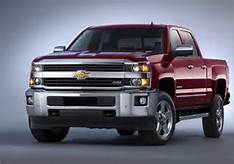Six Ways Silverado Cuts Complexity of Collision Repair
 |
Smart design can reduce time, complexity, cost involved with body repair
DETROIT – Collisions can happen anytime, anywhere, and the resulting body damage frequently results in complicated – and expensive – repairs. Not so much the 2015 Chevrolet Silverado, designed to save time and cost during body shop visits.
“Designing automobiles to be both durable and light
weight is a challenge for the automotive industry,” said John Van
Alstyne, president and CEO of I-CAR,
an international organization focused on sharing new repair procedures
among automotive repair professionals. “Advanced materials may
deliver both qualities, but automakers need to still ensure vehicles are
still designed for affordable reparability.”
When
development work began on the current generation Silverado several years
ago, General Motors’ engineers incorporated several features that
allow technicians to efficiently repair collision damage.
“When we design trucks, we don’t only consider what features
our consumers demand from a full-size truck,” says Mark Szlachta, a
GM serviceability design engineer. “We also approach the process with
our technician hat on, ensuring we engineer a truck that is straightforward
and cost-effective to repair.”
The Silverado reparability
features include:
Front Frame Rail Section
Because
of the way Silverado’s front frame rails are engineered, minor
impacts don’t necessarily equate to substantial repair bills.
Depending on the severity of the impact, technicians may be able to repair
a leading section of the truck’s frame instead of replacing the
entire chassis. If so, the damaged section can be cleanly cut away at a
specific location, and a new service section – shipped fully
assembled – can be welded in place.
Structural Front
Fenders
On many passenger vehicles, unbolting a damaged front
fender removes only the outer skin, leaving behind additional structure
welded to the cab. If that structure is damaged, technicians then need to
drill out welds in order to remove the panel. On the Silverado, the front
fenders incorporate both outer sheet metal and the supporting inner
structure, allowing simple unbolting of the entire assembly.
Bond-On Body Panel Procedures
When it comes to replacing
non-structural body panels, including outer roof panels or outer door
panels, technicians can use an ultra-strong structural adhesive to bond the
panels onto the vehicle. This helps avoid welding and possible corrosion
issues later while speeding the repair.
Pre-prepared roof panels
Technicians can get replacement panels that essentially
plug-and-play, thanks to pre-installed studs and pre-drilled holes for
accessories.
One-Piece Body Side Outers
If damage
occurs to the outer panels of the cab, technicians can order a complete
body side outer, shipped as a single, complete assembly, allowing
technicians to cut out and replace only the damaged area instead of the
entire assembly. “Our goal is to only have weld seams where we
absolutely need them,” Szlachta said.
Flexible Bed Repair Options
If the Silverado’s pickup bed or outer bedside should ever be significantly damaged, owners won’t necessarily need to purchase an new pickup box. Depending on the damage, the outer bedside or the bedside assembly can be replaced from the bed floor out.
Founded in 1911 in Detroit, Chevrolet is now one of the world's largest car brands, doing business in more than 115 countries and selling around 4.8 million cars and trucks a year. Chevrolet provides customers with fuel-efficient vehicles that feature engaging performance, design that makes the heart beat, passive & active safety features and easy-to-use technology, all at a value.


